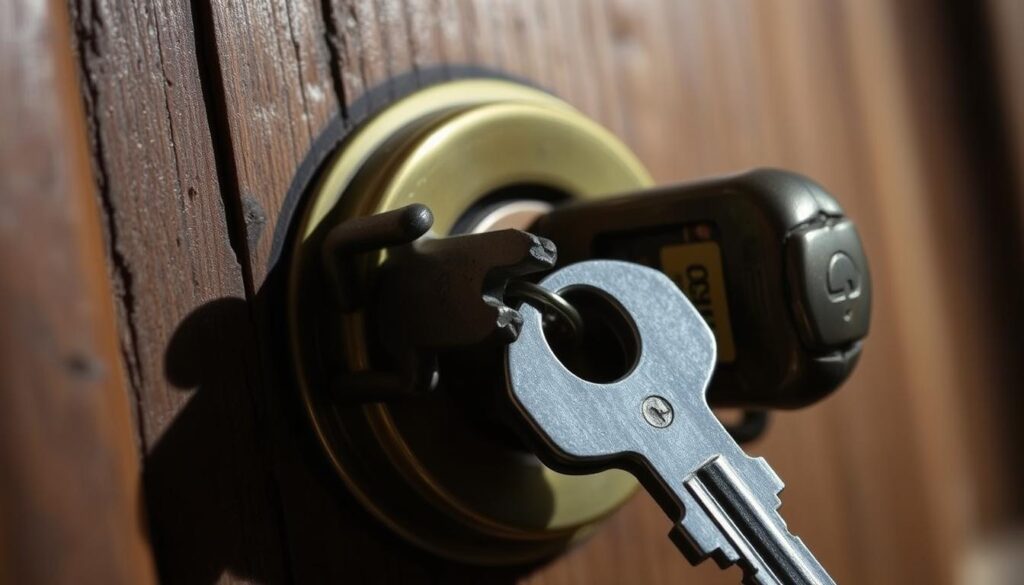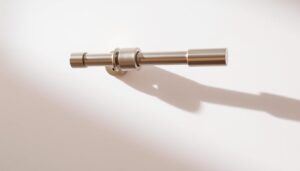Have you ever experienced the frustration of a key breaking off in your lock, leaving you unable to access your home or vehicle? It’s a stressful situation that can happen to anyone.
The crucial first step is to remain calm and assess the situation carefully. Before attempting to extract the broken key, it’s vital to understand the type of lock you’re dealing with and the position of the key fragment within it.
This guide will walk you through effective methods to safely remove the broken key without causing further damage to your lock or door.
Key Takeaways
- Assess the lock type and key break position before attempting extraction.
- Use appropriate tools to avoid pushing the key fragment deeper into the lock.
- Various extraction methods are available, depending on the lock and key situation.
- Preventing further damage is crucial; hence, choosing the right method is key.
- Some methods may require professional assistance if you’re unsure.
Understanding the Broken Key Predicament
Finding yourself with a broken key in a lock can be a stressful experience. It is a situation that requires careful handling to avoid further complications. Understanding the reasons behind a broken key and the appropriate steps to take can make a significant difference.
Why Keys Break in Locks
Keys typically break in locks due to several factors, including wear and tear, poor quality metal, excessive force, or pre-existing damage. Poor lubrication is another significant factor, as it can cause the lock’s internal pins and springs to jam, making it difficult to turn the key. When a key is twisted or damaged, it can snap inside the lock, leading to a broken key situation.
| Cause | Description |
|---|---|
| Wear and Tear | Repeated use weakens keys at their thinnest points. |
| Poor Quality Metal | Keys made from low-quality metal are more prone to breaking. |
| Excessive Force | Applying too much force when turning the key can cause it to break. |
What Not to Do When Your Key Breaks
When a key breaks in a lock, your immediate reaction might be to try and insert the remaining portion to open the lock. This is a critical mistake that can push the broken piece further into the lock. Other mistakes include using inappropriate tools, such as butter knives, which can damage the lock mechanism, or attempting to pick the lock without proper knowledge.
“Before attempting any extraction method, it’s essential to assess whether the broken piece is visible and accessible or completely recessed within the lock cylinder.”
Panicking and applying excessive force can worsen the situation by damaging the lock’s internal components.
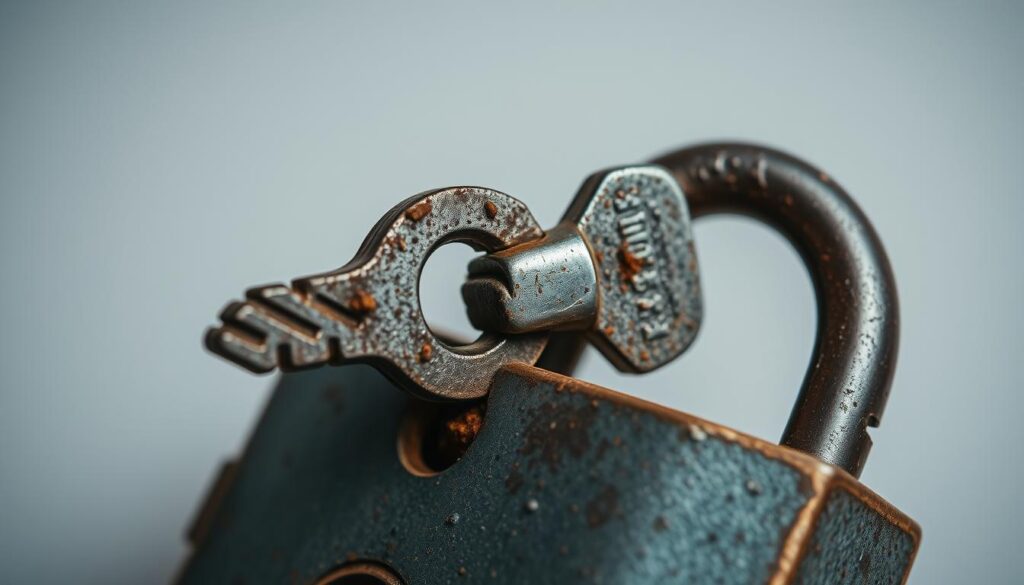
Essential Preparation Before Extraction
Adequate preparation is vital when dealing with a broken key in a lock to ensure a smooth extraction process.
Assessing the Situation
Before attempting to remove a broken key, it’s crucial to properly assess the situation. Examine how much of the key is visible and whether any portion is protruding from the lock. The position of the broken key fragment will determine which extraction method is most likely to succeed.
Gathering the Right Tools
Gathering the right tools beforehand will save time and frustration. Common household items like tweezers, paperclips, and super glue can work in some situations. For more challenging extractions, consider specialized tools like key extractors, thin needle-nose pliers, or jigsaw blades with fine teeth.
Lubricating the Lock
Proper lubrication is a critical step that many people overlook. Applying a suitable lubricant to the lock can significantly ease the extraction process by reducing friction. Graphite powder is often the preferred lubricant for locks as it won’t leave residue that might gum up the mechanism.
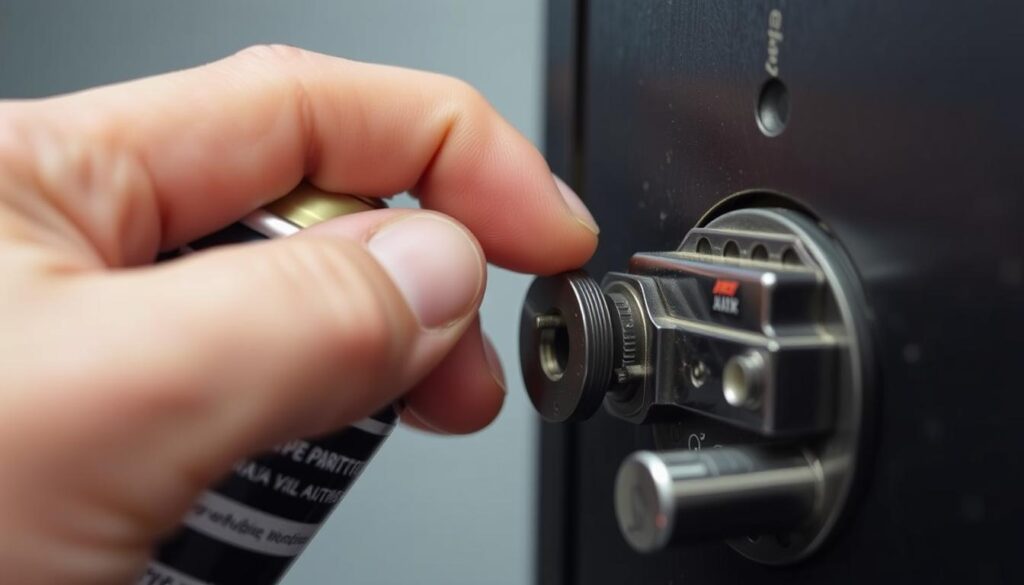
Method 1: Using Tweezers and Pliers
The most straightforward method to remove a broken key from a lock involves using tweezers or needle-nose pliers. This technique is particularly effective when a portion of the key is still visible.
When to Use This Method
You should use tweezers and pliers when a part of the broken key is protruding from the lock, making it accessible for gripping. The effectiveness of this method largely depends on the visibility and accessibility of the broken key fragment.
Step-by-Step Extraction with Tweezers
To extract a broken key using tweezers, first ensure your tweezers are fine-tipped and sturdy enough to fit into the keyway without pushing the key further in. Carefully grip the visible portion of the key and gently pull it straight out, avoiding any twisting motions.
Tips for Success
For successful extraction, maintain steady pressure and avoid jerking movements. If the tweezers or pliers slip, try wiping the exposed key portion dry or applying a small piece of adhesive tape to the tool tips for a better grip. Needle-nose pliers can offer a stronger grip than tweezers, but they require more space to manoeuvre.
Method 2: How to Remove Broken Key from Lock with Extraction Tools
Extraction tools offer a reliable solution for removing broken keys from locks without causing damage. These tools are designed to grip the broken key fragment and pull it out gently.
Professional Key Extractors
Professional key extractors are specialized tools designed specifically for removing broken keys from locks. They feature thin, hooked ends that slide alongside the broken key fragment to grip its serrated edge and pull it out of the lock cylinder.
Key extraction kits usually contain multiple tools with different hook configurations to accommodate various types of locks and key break positions.
DIY Alternatives: Jigsaw Blades and Hacksaw Blades
For those without access to professional extractors, DIY alternatives can be fashioned from common tools like jigsaw blades or mini hacksaw blades. Look for thin, flexible metal pieces that can be inserted into the keyway alongside the broken key fragment.
The serrated edge of a jigsaw blade works similarly to a professional extractor by catching on the key’s teeth when inserted with the teeth pointing downward.
Extraction Technique
The extraction technique involves carefully inserting the extractor tool into the keyway alongside the broken key, rotating it slightly to hook onto the key’s teeth, then gently pulling outward. Multiple attempts may be necessary, as the extractor needs to catch on the key’s bitting to successfully remove it from the lock.
Patience is crucial during this process – rushing can push the key fragment deeper or damage the lock’s internal components.
Method 3: Alternative Extraction Techniques
If conventional methods fail, alternative extraction techniques can help you remove a broken key from a lock. These methods might seem unorthodox, but they can be effective in the right situations.
The Super Glue Method
The super glue method involves applying a small amount of cyanoacrylate to the end of a thin object, such as a matchstick or wire, and then attaching it to the exposed edge of the broken key. This technique works best when a portion of the key is visible and accessible. It’s crucial to avoid getting glue on the lock mechanism to prevent damage. When done correctly, you can carefully pull out the broken key.
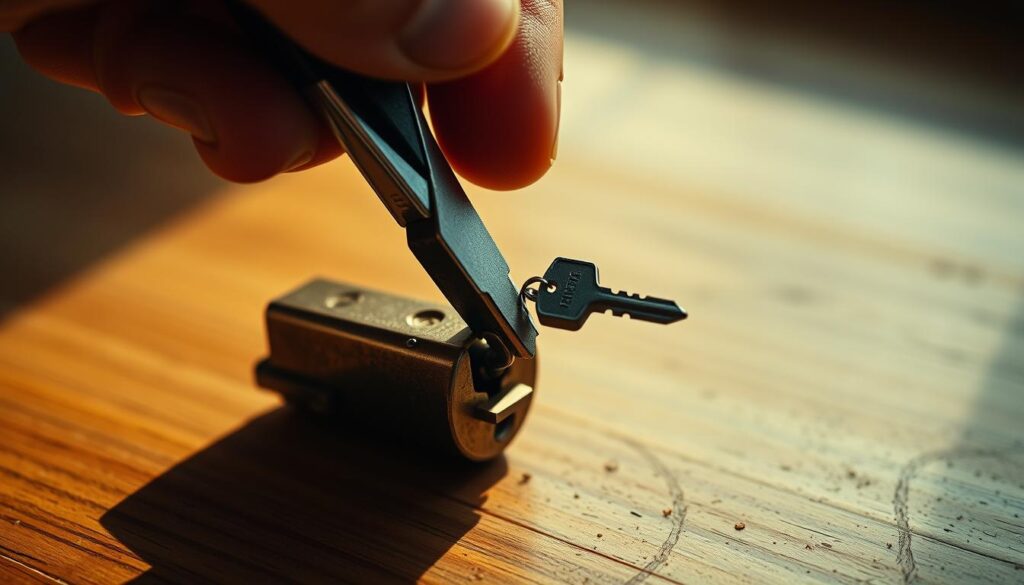
Tapping the Cylinder
The tapping cylinder technique uses gravity and controlled impact to dislodge the broken key fragment. To do this, position the lock with the keyhole facing downward. Then, gently tap the side of the lock cylinder with a rubber mallet or the handle of a screwdriver. This creates vibrations that may loosen the key fragment, allowing it to fall out due to gravity.
The Probe and Pull Technique
The probe and pull technique involves using two thin pieces of metal, such as paperclips or lock picks, inserted on either side of the broken key. By applying gentle outward pressure with both probes simultaneously, you can gradually work the key fragment out of the lock. This method requires patience and a steady hand but can be effective when other techniques have failed.
| Method | Description | Effectiveness |
|---|---|---|
| Super Glue Method | Using cyanoacrylate to attach a tool to the broken key | High, if done carefully |
| Tapping the Cylinder | Using gravity and vibrations to dislodge the key | Moderate, depends on lock position |
| Probe and Pull Technique | Using thin metal probes to extract the broken key | High, requires skill and patience |
When to Call a Professional Locksmith
Knowing when to call a professional locksmith can save you time and prevent further damage to your lock. While DIY methods can be effective, there are situations where seeking professional help is the best course of action.
Signs You Need Professional Help
If you’ve attempted to remove a broken key from your lock without success, it may be time to call a professional. Signs that indicate the need for professional assistance include:
- Multiple extraction attempts have failed or pushed the key fragment deeper into the lock.
- The lock mechanism shows signs of damage, such as unusual resistance or grinding sounds.
- You are unsure about the type of lock or the best method for key extraction.
Searching for an “emergency locksmith near me” can provide you with a quick solution.
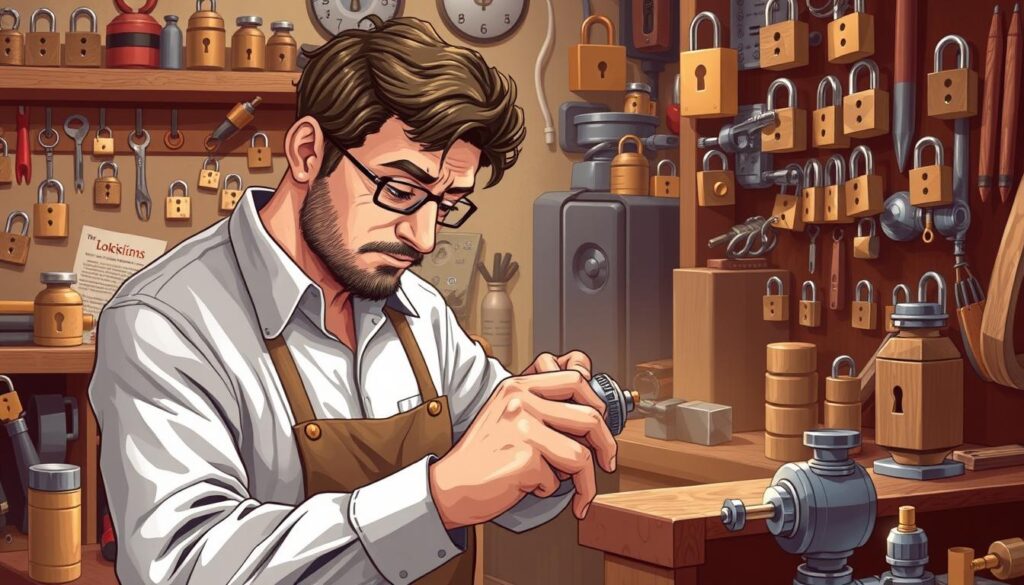
What to Expect: Costs and Services
The cost of hiring a locksmith can vary depending on the type of lock, the complexity of the problem, and the time of day. Typically, the cost includes:
- A call-out fee.
- Labour charges based on time and complexity.
- Potential costs for replacement parts if needed.
The average cost for professional broken key extraction ranges from £50 to £150. Many locksmiths offer 24/7 emergency services, although these may come at a premium rate.
Preventing Future Key Breakages
A broken key can be a significant inconvenience, but there are steps you can take to minimise the risk. To prevent keys from breaking, it’s crucial to maintain your locks regularly. This includes periodic cleaning and lubrication of the lock mechanism using graphite powder or silicone-based lubricants, which are specifically designed for locks.
Regularly inspecting your keys for signs of wear, bending, or small cracks can also help identify potential issues before they lead to a broken key. It’s also advisable to have duplicate keys made from original keys rather than copying existing copies, as this can lead to a loss of precision and increased risk of breakage. For more detailed steps on handling a broken key, you can refer to our guide on how to handle a broken key.
When using keys, especially in cold weather, apply gentle and even pressure rather than forcing the key if you encounter resistance. Consider upgrading to high-quality locks and keys made from durable materials that are less likely to wear down or break under normal use. For frequently used locks, consider having a professional locksmith perform annual maintenance to ensure smooth operation.
Proper storage of keys is also essential to prevent bending or damage. Avoid overloaded keyrings that put stress on keys, and address any issues with locks promptly to prevent the need for excessive force, which can lead to broken keys. By following these tips, you can significantly reduce the likelihood of experiencing a broken key in the future.
